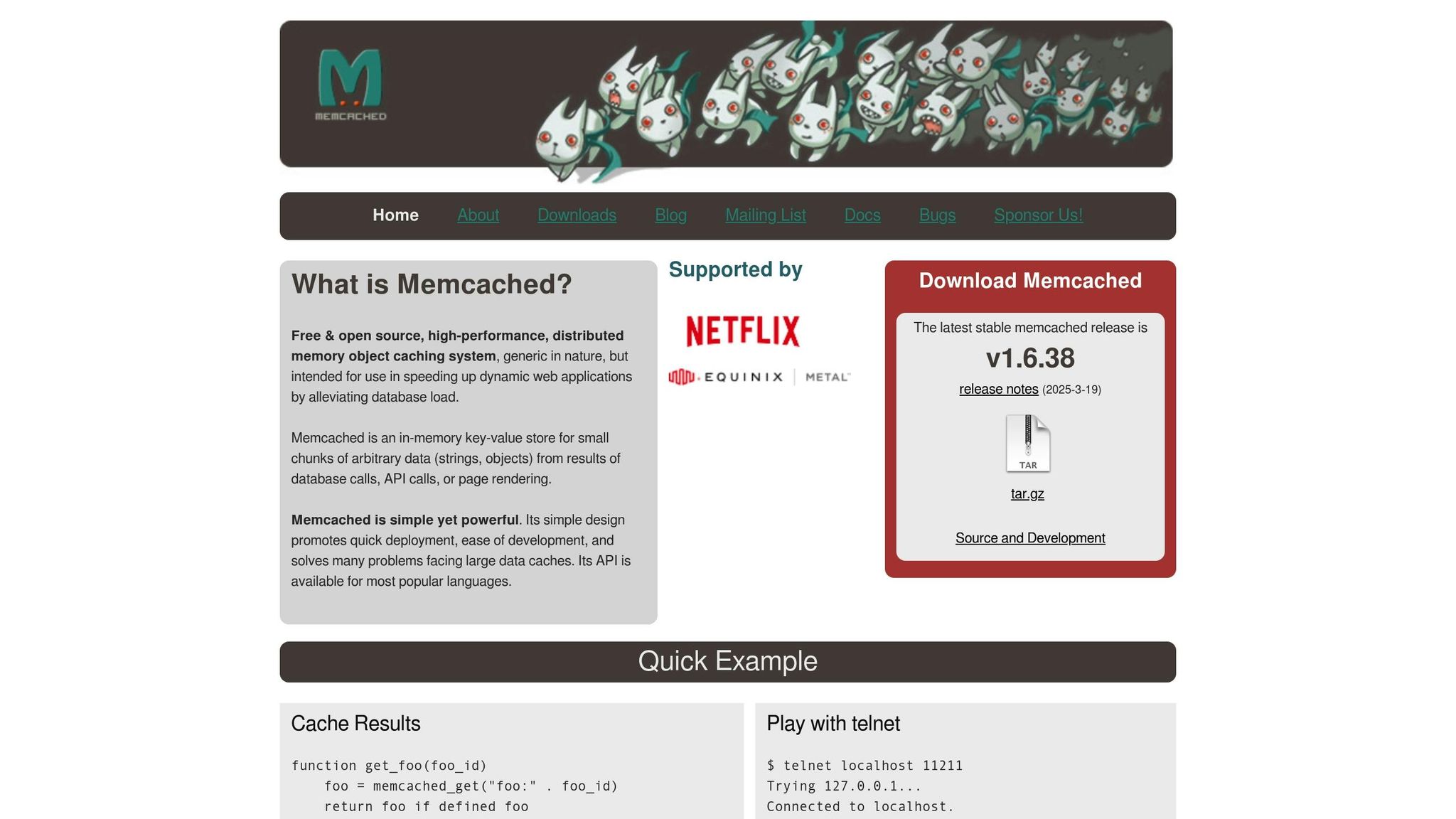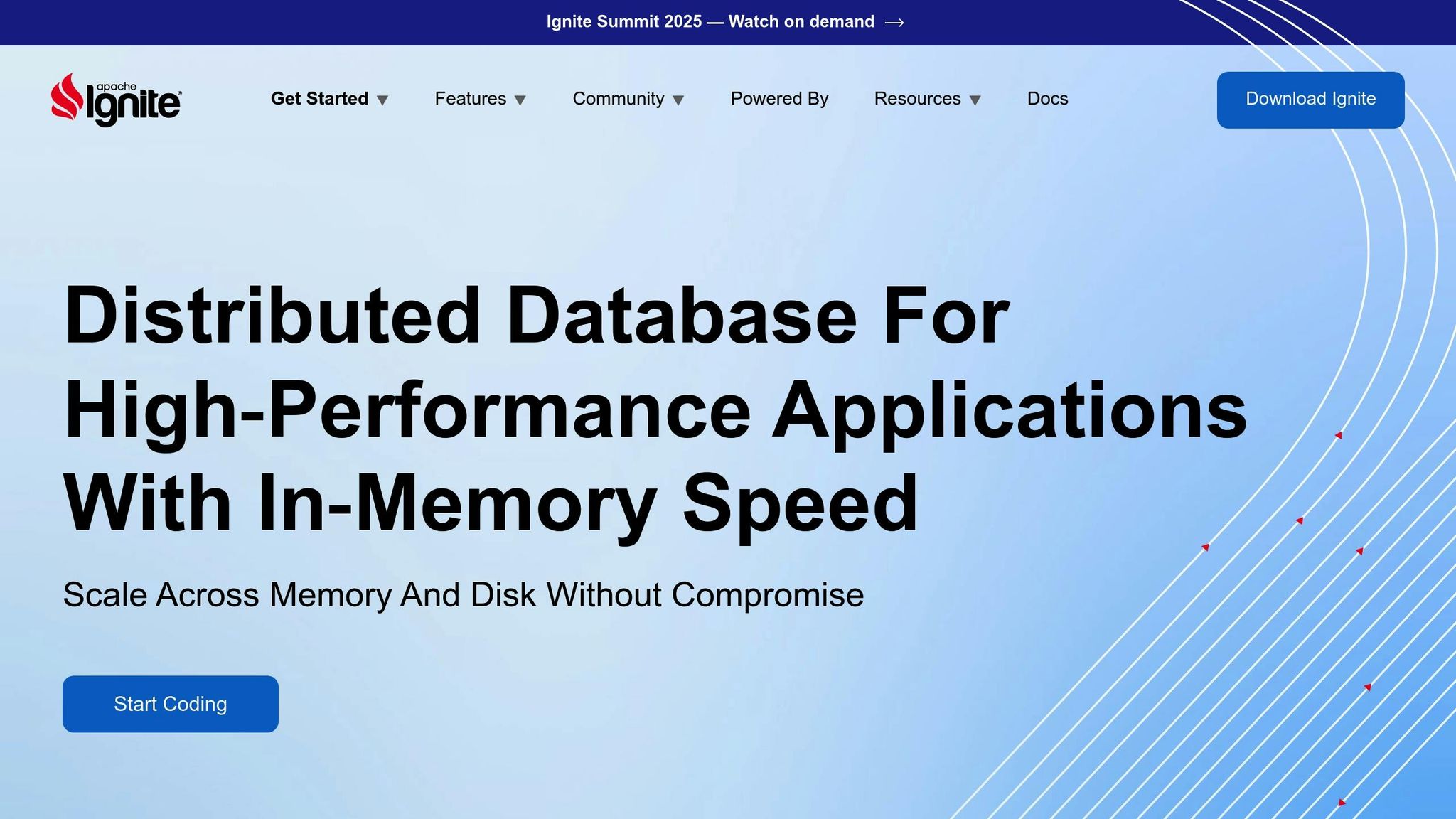DistributedCachingforHigh-TrafficAPIs
2025-08-06

When your API handles thousands of requests every second, speed and efficiency are non-negotiable. Distributed caching is a proven way to reduce response times and ease database workloads by storing frequently accessed data in memory across multiple servers. This approach not only improves performance but also helps scale systems cost-effectively.
Here’s what you need to know:
- Redis: Fast, flexible, and reliable, with support for advanced data structures. Ideal for general-purpose caching but requires careful configuration for high availability.
- Memcached: Simple and efficient for read-heavy workloads. Great for transient data but lacks persistence and fault tolerance.
- Couchbase: Combines caching with database features, offering powerful querying and analytics. Suited for complex use cases but has a steeper learning curve.
- Apache Ignite: Offers distributed caching with SQL support and in-memory computing. Excellent for heavy data processing but can be complex to set up.
- Aerospike: Designed for ultra-low latency and massive data volumes. Best for write-heavy scenarios but may not fit simpler needs.
- Hazelcast: Reliable for enterprise-level caching with strong fault tolerance. Works well for always-on applications but may feel overkill for smaller projects.
Quick Comparison
| Solution | Best For | Strength | Limitation |
|---|---|---|---|
| Redis | General-purpose caching | Speed and flexibility | Single-threaded, limited querying |
| Memcached | Simple, high-performance caching | Easy to use, multi-threaded | No persistence, basic feature set |
| Couchbase | Cache + database applications | Advanced querying, analytics | Higher complexity |
| Apache Ignite | Enterprise data processing | Distributed SQL, scalability | Complex setup |
| Aerospike | Write-heavy, low-latency workloads | SSD optimisation, high throughput | Specialised use cases |
| Hazelcast | Enterprise fault-tolerant systems | Strong fault tolerance | Enterprise-focused complexity |
Choosing the right caching solution depends on your specific needs, including traffic patterns, data consistency requirements, and available expertise. Start simple with tools like Memcached or Redis, and scale up to more advanced solutions like Couchbase or Aerospike as your requirements grow.
1. Redis

Redis is a lightning-fast, distributed caching system that stores data in memory, delivering speeds measured in micro- to nanoseconds. This makes it a go-to solution for high-traffic APIs where performance is key.
Redis Cluster distributes data across 16,384 hash slots, enabling horizontal scaling with ease. However, adapting to Redis Cluster may require some code adjustments due to differences in how certain commands function.
Fault Tolerance and High Availability
Reliability is a core strength of Redis, thanks to Redis Sentinel. This distributed service continuously monitors the health of master and replica nodes within a cluster. If a node fails, Sentinel steps in to perform an automatic failover, ensuring minimal disruption. For critical applications, Redis can achieve an impressive 99.999% availability.
Redis's fault tolerance becomes even more robust when clusters span multiple availability zones. Redis Enterprise, for instance, needs only two replicas to maintain high availability and can handle failovers in just a few seconds without manual intervention. This is a step ahead of open-source Redis, which typically requires three replicas for comparable reliability.
High-Traffic Performance
Redis shines under heavy workloads. For example, BioCatch relies on Redis Enterprise to support 70 million users, handling 40,000 operations per second across 5 billion monthly transactions - all with zero downtime. Similarly, Gap Inc. uses Redis Enterprise to deliver real-time shipping updates during high-demand periods like Black Friday, when API traffic spikes significantly. Meanwhile, Freshworks leverages Redis Enterprise Cloud to reduce strain on MySQL databases and speed up application responses across a variety of scenarios.
Optimisation Strategies
Redis performance can be further fine-tuned using a few key strategies. Pipelining helps minimise network overhead, while setting appropriate TTL (time-to-live) values ensures outdated data is automatically removed. Additionally, connection pooling reuses existing connections, reducing overhead.
| Performance Requirement | Redis Mechanism | Implementation Cost |
|---|---|---|
| Data durability | AOF with fsync=always | High I/O overhead |
| Crash recovery | RDB and replication | Potential snapshot staleness |
| Write consistency | WAIT command | Increased latency, blocking |
Redis's versatile data structures - such as strings, hashes, lists, sets, and sorted sets - allow it to efficiently model complex data relationships. Beyond caching, Redis supports Lua scripting and pub/sub messaging, making it a powerful tool for real-time applications.
2. Memcached

Memcached is a fast, distributed memory object caching system designed to ease the strain on databases. By storing data entirely in RAM, it ensures quick access, making it an excellent choice for applications that demand rapid data retrieval. Cached items can be served in under a millisecond, thanks to its operations being nearly all O(1).
Scalability and Architecture
Memcached's architecture is built for horizontal scalability, allowing additional servers to be added seamlessly. It uses consistent hashing to distribute keys evenly across servers, preventing performance bottlenecks.
The system's performance is impressive. On high-performance machines with fast networking, Memcached can process over 200,000 requests per second. Benchmark tests conducted on AWS EC2 instances highlight its capabilities:
| Instance Type | Configuration | Operations per Second | P90 Latency | P99 Latency | Throughput |
|---|---|---|---|---|---|
| m5.2xlarge | 8 vCPUs, 32 GB RAM | 1,200,000 | 0.25 ms | 0.35 ms | 1.2 GB/s |
| c5.2xlarge | 8 vCPUs, 16 GB RAM | 1,300,000 | 0.23 ms | 0.33 ms | 1.3 GB/s |
| 10-node cluster (m5.2xlarge) | 8 vCPUs, 32 GB RAM | 12,000,000 | 0.35 ms | 0.45 ms | 12.0 GB/s |
Fault Tolerance Limitations
One of Memcached's key limitations is its lack of built-in persistence and advanced fault tolerance mechanisms. It uses an LRU (Least Recently Used) eviction policy to manage memory efficiently, but this also means data is lost if a server goes down. As a result, Memcached is best suited for transient data like session information or precomputed results.
Implementation Best Practices
Memcached's multithreaded design, combined with libevent-backed sockets, allows it to handle tens of thousands of simultaneous connections. To maximise performance, developers should follow these best practices:
- Keep key names under 250 characters and use consistent naming conventions.
- Use persistent connections instead of creating a new one for each request to minimise latency.
- Implement command pipelining to reduce round-trip times in network-heavy environments.
- Configure appropriate Time-To-Live (TTL) values for volatile data to ensure efficient memory usage.
When implemented properly, Memcached excels in scenarios with frequent reads and infrequent updates, reducing database load by caching results from database queries, API calls, and page rendering processes. Up next, we’ll explore how these caching solutions compare, highlighting the trade-offs for high-traffic API caching.
3. Couchbase

Couchbase is a NoSQL database that combines the speed of in-memory operations with the reliability of persistent storage. Its distributed setup makes it a top choice for high-traffic APIs, where both fast performance and dependability are non-negotiable.
Scalability and Architecture
Couchbase's architecture revolves around vBuckets, which distribute data evenly across cluster nodes. Each bucket is divided into 1,024 vBuckets, ensuring balanced workloads without requiring changes at the application level.
As explained in Couchbase's documentation:
"One or more instances of Couchbase Server constitute a cluster, which replicates data across server-instances, and across clusters; and so ensures high availability."
One of Couchbase's strengths is its ability to scale individual services independently. Whether it's the data, index, query, eventing, or analytics services, each can be scaled according to specific needs. For instance, during read-heavy periods, query nodes can be added, while storage-heavy scenarios might require scaling up data nodes. This flexibility ensures that no single service impacts the performance of others. Additionally, Cross Datacenter Replication (XDCR) allows data replication across clusters in different locations [36,38], and Server Group Awareness helps minimise disruptions by grouping nodes strategically. Together, these features create a sturdy system capable of handling demanding workloads.
Performance Benchmarks
Couchbase's memory-first architecture ensures exceptional speed by prioritising data retrieval from RAM before turning to disk storage [38,40]. This design enables it to process millions of operations per second, all while maintaining sub-millisecond response times [41,42].
Real-world examples highlight its capabilities:
- LinkedIn uses Couchbase for caching, handling over 10 million queries per second with an average latency of under 4ms.
- Paddy Power Betfair processes 1 million transactions per second and manages 500,000 events in just 3 minutes.
- FICO achieves response times of less than 1ms, thanks to Couchbase's replication technology.
- BroadJump reported a 500% improvement in query performance, while Nielsen experienced a 50% boost in response times.
These examples demonstrate how Couchbase excels under heavy loads, making it a reliable option for businesses with demanding performance requirements.
Fault Tolerance and Resilience
Couchbase is designed to keep running, even when things go wrong. Features like Durable Writes ensure that data changes remain invisible until durability is confirmed, reducing the risk of data loss during hardware failures. The system can handle node additions, removals, and failures without losing data. Additionally, the combination of synchronous replication and multi-document ACID transactions strengthens data consistency and durability. When paired with XDCR, Couchbase can even withstand entire data centre outages.
As Claus Moldt, CIO of FICO, noted:
"We found that the replication technology across data centres for Couchbase was superior, especially for the large workloads."
Implementation Considerations
Couchbase is a robust solution for scenarios requiring both high performance and persistent storage. Its architecture ensures fast responses while maintaining data durability, making it more than just a caching system. For instance, during power failures or system restarts, Couchbase preserves data integrity. A great example of its effectiveness is Amadeus IT Group, which reduced its total cost of ownership by 50% by leveraging Couchbase's cloud capabilities and running data stores on a Platform-as-a-Service infrastructure.
With features like clustering for redundancy and sharding via vBuckets, Couchbase offers a scalable and fault-tolerant setup. This makes it a valuable choice for APIs that demand both speed and reliable data handling.
4. Apache Ignite

Apache Ignite is an in-memory data grid that goes beyond basic caching by incorporating distributed computing capabilities. Its architecture blends high-speed caching with features like distributed SQL processing and service deployment, making it a strong choice for managing complex, high-traffic API environments.
Scalability and Architecture
Apache Ignite supports both horizontal and vertical scaling, allowing systems to handle growing traffic more effectively. By distributing data through consistent hashing and sharding, and prioritising memory-first operations, Ignite ensures faster performance as more data is cached in RAM.
One of Ignite's standout features is affinity colocation, which reduces network overhead for join and aggregation operations. This is especially useful for APIs that need to handle large datasets with frequent joins or aggregations. Additionally, its service grid enables microservices to be deployed and scaled directly within the data grid. This integration of data and compute operations makes Ignite more than just a caching tool - it’s a comprehensive platform for demanding API use cases.
GridGain Systems highlights Ignite's versatility:
"Ignite is typically used to: Add speed and scalability to existing applications; Build new, modern, highly performant and scalable transactional and/or analytical applications; Build streaming analytics applications, often with Apache Spark, Apache Kafka™ and other streaming technologies; Add continuous machine and deep learning to applications to improve decision automation."
Ignite offers flexibility in deployment, supporting on-premises, private cloud, public cloud, and hybrid environments.
Performance Benchmarks
Apache Ignite's performance strikes a balance between speed and efficiency. In tests, loading 2 million records took 135.695 seconds - slower than Java Native HashMap's 114.525 seconds but much faster than Hazelcast's 301.015 seconds.
Where Ignite shines is in memory efficiency. The same dataset of 2 million physician profiles used just 24 MB of memory in Ignite, compared to 2,530 MB for Java Native HashMap and 1,448 MB for Hazelcast. This efficiency makes it ideal for large-scale deployments where memory usage is a critical factor.
In terms of read performance, Ignite averages 3.432 milliseconds per response. While not the fastest in isolated tests, this performance remains competitive when considering its distributed architecture and added features. Its partition-aware data loading ensures stable performance, even with massive datasets.
Fault Tolerance and Resilience
Apache Ignite is built with fault tolerance in mind. The platform includes automatic job failover, which shifts tasks to available nodes if one crashes. This ensures API requests are handled without interruption.
The system also uses cluster singleton deployment to guarantee continuous service availability. If a node fails, services are automatically redeployed to healthy nodes. As stated in the documentation:
"Ignite always guarantees that services are continuously available, and are deployed according to the specified configuration, regardless of any topology changes or node crashes."
With the release of Apache Ignite 3.0, a Raft-based consensus mechanism was introduced, improving cluster stability and fault tolerance. Data redundancy can be configured by setting multiple backup copies across nodes, protecting against data loss. Furthermore, dynamic service redeployment ensures minimal downtime during maintenance, as clusters do not need to be restarted. These features make Ignite a resilient choice for high-demand applications.
Implementation Considerations
Apache Ignite is well-suited for high-performance caching and advanced data processing. Its ANSI-99 compliant distributed SQL support enables complex queries across distributed datasets. Developers can also fine-tune its ACID transaction support to balance consistency and performance.
For API use cases, Ignite's ability to handle both transactional and analytical workloads makes it a valuable tool for applications needing real-time insights alongside rapid data access. It can serve as a replacement for traditional solutions like Cassandra, particularly in scenarios requiring high-volume read and write operations with SQL flexibility.
To optimise Ignite deployments, monitoring metrics like cache hit rates, memory usage, and network traffic is essential. Pre-populating critical data through cache warming strategies helps avoid delays caused by cold starts, while designing for graceful degradation ensures APIs remain functional even during node failures. By combining advanced caching with in-memory computation, Ignite strengthens the foundation for building scalable, high-traffic APIs.
sbb-itb-1051aa0
5. Aerospike

Aerospike stands out as a distributed key-value database designed for low-latency and high-throughput operations. This makes it particularly effective in handling demanding API environments. By combining fast in-memory processing with persistent storage, Aerospike is well-suited for high-traffic applications.
Scalability and Architecture
Aerospike's architecture is built for scalability, featuring three main layers: client, clustering, and storage. The client layer dynamically tracks the cluster state, ensuring requests are routed to the correct node efficiently, avoiding unnecessary network hops.
Its hybrid memory architecture is a key feature, storing indexes in memory while saving data on SSDs. This approach delivers RAM-level performance while keeping infrastructure costs lower. Data is evenly distributed across nodes using a sharding mechanism that generates a 160-byte digest from each record's primary key, assigning it to one of 4,096 partitions. Impressively, the system can manage 1 billion keys using only 64 GiB of memory across the cluster. Tests on Amazon EC2 have shown Aerospike scales linearly, handling up to 140,000 transactions per second on eight nodes with an 80/20 read/write workload.
Performance Specifications
Aerospike shines in performance benchmarks. On Google Compute Engine, it achieved 1 million writes per second across 50 nodes and 1 million reads per second across 10 nodes. Its out-of-place update mechanism enhances write throughput without compromising read speeds. Additionally, by leveraging flash storage instead of DRAM, Aerospike reduces infrastructure costs by up to 80% while maintaining sub-millisecond latency.
Fault Tolerance Mechanisms
Fault tolerance is another area where Aerospike excels. It employs a combination of gossip, mesh, and heartbeat protocols for managing cluster membership, peer communication, and node health. To ensure resilience, Aerospike uses N+1 replication, automatic failover, and Cross-Datacenter Replication (XDR), striking a balance between consistency, availability, and cost. Its automatic failover system redistributes data to healthy nodes, minimising downtime.
For disaster recovery, XDR allows data replication across geographically distributed clusters. The platform supports both synchronous and asynchronous replication, giving users flexibility in prioritising consistency or performance. Depending on the application, Aerospike can operate in high-availability (AP) mode or strong consistency (CP) mode.
Implementation Use Cases
Aerospike is ideal for use cases requiring both the speed of caching and the reliability of database persistence. For instance, a global asset company used Aerospike to cache Snowflake data for advanced analytics. This setup enabled real-time data ingestion and improved personalisation and market risk analysis, with machine learning models processed and batched through data APIs. Aerospike served as a low-latency datastore integrated with the Snowflake enterprise platform.
In API implementations, Aerospike’s support for bins allows developers to handle multiple items in a single transaction, reducing network overhead. Its smart client design ensures single-hop data access, cutting down on latency and network traffic. To optimise performance, it’s recommended to adjust the replication factor based on fault tolerance needs, fine-tune consistency settings for reads and writes, and monitor cluster health using tools like "asd" and "aerospike-admin".
6. Hazelcast

Hazelcast stands out among caching systems with its focus on speed, scalability, and resilience, making it a strong choice for high-traffic APIs. It’s an open-source, distributed in-memory data grid (IMDG) that combines a compute engine with a fast data store in a single runtime. This combination equips it to handle real-time and AI-powered applications that deal with heavy API traffic.
Scalability and Architecture
Hazelcast’s architecture integrates the RAM of all cluster members into a unified in-memory data store, enabling quick data access across the cluster. It supports distributed data structures like maps, queues, sets, and locks, which are automatically spread across the cluster. This allows for horizontal scaling through automatic partitioning and replication. Its peer-to-peer design eliminates single points of failure and supports parallel compute operations. Each node in the cluster contributes by storing part of the data and performing compute tasks simultaneously.
To boost performance further, Hazelcast offers a High-Density Memory Store (HDMS). This feature uses native, off-heap memory for storing object data instead of relying on the JVM heap, reducing garbage collection overhead and increasing throughput. This architecture underpins Hazelcast’s ability to deliver both performance and fault tolerance.
Performance Features
Hazelcast is designed for efficiency, even on low-spec devices like the Raspberry Pi Zero, demonstrating its resource-friendly nature. For the best results, cluster members should have equal CPU, memory, and network resources. Using dedicated NICs ensures smooth data flow and minimises bottlenecks.
Fault Tolerance
For APIs that require uninterrupted operation, Hazelcast’s fault tolerance features are indispensable. It uses distributed snapshots based on the Chandy-Lamport algorithm to back up job states in its own map objects, which are replicated in-memory structures. This ensures data consistency without needing external systems like ZooKeeper. Additionally, split-brain protection safeguards against network partitions by allowing jobs to restart only in clusters with more than half of their original nodes. Built-in replication and failover mechanisms further ensure data durability and consistency, even when nodes fail.
Real-World Applications
Hazelcast shines in scenarios where response times need to be under milliseconds, making it a popular choice in industries like financial services, telecommunications, and logistics. Some practical applications include:
- Distributed session management for large-scale web applications
- Real-time leaderboards and scoring systems
- Microservices communication via distributed pub/sub
- Fraud detection using event stream processing
- Real-time analytics pipelines in manufacturing and logistics
To achieve the best results, it’s essential to size clusters appropriately based on memory, CPU, and network needs. Configuring private networks and firewalls adds security, while optimising data structures and serialisation helps reduce data size and boosts system performance.
Comparison: Pros and Cons
This section pulls together the key strengths and weaknesses of each caching solution, helping you make an informed choice based on your specific needs.
Performance and Speed Characteristics
Redis is widely recognised for its speed and versatility, offering rich data structures beyond simple key–value storage. However, its limited query capabilities and single-threaded architecture can present challenges under high concurrency.
Memcached shines in simplicity and performance. Its multi-threaded design ensures quick handling of read-heavy workloads, and it’s praised for ease of use - scoring 9.4/10 in user reviews.
Aerospike is built for ultra-low latency and exceptional throughput. Its SSD-optimised design makes it ideal for write-heavy workloads, particularly in scenarios that demand consistent handling of massive data volumes.
Scalability and Enterprise Features
Apache Ignite stands out for its scalability, offering advanced distributed data processing and SQL support. However, its complexity can be a drawback, with lower ratings for ease of setup (7.8) and administration (7.5).
Hazelcast is a strong contender for enterprise environments, offering robust fault tolerance and cloud-native features. It’s a reliable choice for organisations needing dependable, always-on caching with minimal operational hassle.
Couchbase bridges the gap between caching and database functionality. It provides advanced querying, analytics, and reporting capabilities, making it a great fit for applications that need more than just caching.
Operational Considerations
Memcached is celebrated for its simplicity, with a straightforward setup and maintenance process. It holds a 4.7 out of 5 rating and is particularly favoured by small businesses, which account for 68.8% of its user reviews.
On the other hand, Apache Ignite requires more operational expertise and is more commonly adopted by mid-market businesses (35.3% of reviews).
Feature Depth and Functionality
Users on G2 have highlighted the following:
"Apache Ignite provides robust data management features, including ACID compliance and advanced indexing, which are essential for applications requiring strong transactional support, while Memcached lacks these capabilities."
This quote captures a key trade-off: balancing simplicity with advanced functionality. Redis offers a middle ground with versatile data structures, while Couchbase stands out for its comprehensive querying and analytical features, appealing to applications that need both caching and database capabilities.
| Solution | Best For | Key Strength | Main Limitation |
|---|---|---|---|
| Redis | General-purpose caching with data needs | Speed and flexibility | Limited query capabilities |
| Memcached | Simple, high-performance caching | Ease of use (9.4/10) and multi-threading | Basic feature set |
| Couchbase | Cache + database applications | Advanced querying and analytics | Higher complexity |
| Apache Ignite | Enterprise data processing with SQL | Scalability and ACID compliance | Complex setup and administration |
| Aerospike | Write-heavy, ultra-low latency workloads | SSD optimisation and massive data handling | Specialised use cases |
| Hazelcast | Enterprise fault-tolerant applications | Robust fault tolerance and cloud compatibility | Enterprise-focused complexity |
For teams with straightforward caching needs, Memcached is often the go-to choice. However, if your requirements include advanced processing or analytics, Apache Ignite or Couchbase may be worth the extra setup effort. For more guidance on integrating these solutions into scalable API architectures, visit Antler Digital at https://antler.digital.
Conclusion
Selecting the right distributed cache depends on balancing performance, complexity, and operational requirements. Here's a quick breakdown to help you evaluate the best option for your needs.
For straightforward caching needs, Memcached is a reliable, simple, and multi-threaded choice. It's perfect for read-heavy workloads and smaller businesses looking for an easy-to-deploy solution with minimal overhead.
Redis, on the other hand, offers versatility with its rich data structures and strong performance. While it operates on a single-threaded model, Redis is well-suited for diverse API caching scenarios and strikes a good balance between functionality and operational simplicity.
For enterprise-level demands, Apache Ignite is ideal for those needing ACID transactions and SQL support, though its setup can be more complex. Hazelcast, with its robust fault tolerance and cloud-native features, is better suited for always-on enterprise applications.
If you’re dealing with write-heavy, ultra-low latency use cases, Aerospike stands out with its SSD optimisation. It’s designed for large data volumes and real-time analytics, making it a strong choice for high-throughput applications, though its specialised focus may not suit all scenarios.
Couchbase is a great fit for hybrid caching and database needs, combining traditional caching with advanced querying and analytics. This makes it ideal for applications that have outgrown simple key-value caching but don’t yet require a separate database solution.
"Scalability is not application performance. It is application performance under peak loads."
This insight from Iqbal Khan serves as a reminder for UK businesses: your caching solution must deliver consistent performance, even during peak traffic periods. Factors like traffic patterns, data consistency requirements, and your team’s expertise should guide your decision.
Pricing varies widely, from managed services like Azure Cache for Redis starting at £1.11 per month, to enterprise-grade solutions like SwiftCache, which can cost up to £550 per server monthly. Beyond licensing costs, consider operational overhead and the expertise needed for maintenance.
For organisations building scalable API architectures, Antler Digital offers tailored technical guidance in designing high-performance distributed systems. Visit https://antler.digital to see how these strategies can be customised for your needs.
Start with proven solutions like Memcached or Redis and scale up as your requirements evolve.
FAQs
How does distributed caching enhance the performance of APIs handling high traffic?
Distributed caching plays a key role in boosting the performance of high-traffic APIs. By keeping frequently accessed data closer to users, it reduces the strain on backend systems and cuts down response times. This means fewer repeated database queries, leading to quicker and more dependable responses.
Another advantage is its ability to support scalability on demand. By distributing cached data across multiple servers, it ensures that APIs can handle sudden surges in traffic without a dip in performance. It's a critical tool for creating systems that are both efficient and capable of scaling effortlessly.
What should you consider when selecting a distributed caching solution like Redis, Memcached, or Couchbase?
When deciding on a distributed caching solution, it’s important to weigh factors like performance, scalability, data complexity, ease of management, and cost. Different tools cater to different needs, so it’s worth considering the specifics of your use case:
- Redis: A great option if you need support for complex data structures or require data persistence.
- Memcached: A simple, lightweight choice for straightforward caching tasks.
- Couchbase: Offers a blend of caching and database functionalities, making it a good fit for integrated applications.
The best choice will depend on your workload, data model, and how much scalability you need. If you’re looking for expert help in creating scalable APIs, Antler Digital can assist in designing solutions that deliver high performance and reliability.
What is the difference between fault tolerance and scalability in distributed caching solutions?
Fault tolerance in distributed caching plays a crucial role in keeping systems running smoothly, even when individual nodes fail. This is often managed through data replication and redundancy, which help prevent data loss and ensure the system stays available.
On the other hand, scalability is all about the system's capacity to handle growing traffic effectively. This is usually achieved by adding more nodes or spreading data across multiple servers. While some caching solutions emphasise fault tolerance by implementing extensive replication, others focus on scalability using methods like sharding or partitioning. The choice between these approaches usually hinges on the specific needs of the API and the anticipated traffic patterns.
Lets grow your business together
At Antler Digital, we believe that collaboration and communication are the keys to a successful partnership. Our small, dedicated team is passionate about designing and building web applications that exceed our clients' expectations. We take pride in our ability to create modern, scalable solutions that help businesses of all sizes achieve their digital goals.
If you're looking for a partner who will work closely with you to develop a customized web application that meets your unique needs, look no further. From handling the project directly, to fitting in with an existing team, we're here to help.
